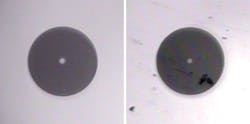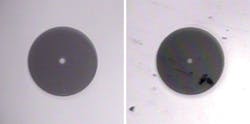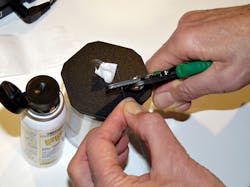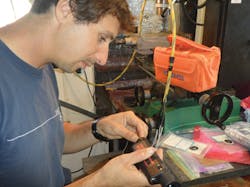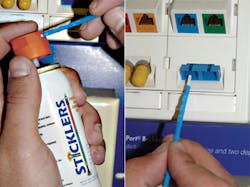The importance of properly cleaning fiber during termination
From the August, 2014 Issue of Cabling Installation & Maintenance Magazine
Proper knowledge and the right tools are essential to keeping fiber free from contamination.
by Sean Sheedy
Using a medium only slightly larger than a human hair, fiber-optic communication has transformed our world. Not only have fiber-optic communications eliminated the vast majority of previous network limitations, but this technology also has expanded the capabilities of networks far beyond previous expectations. Today's world of mobile communications and video downloads is a direct result of the rapid and affordable deployment of powerful, reliable fiber-optic networks. If anyone ever develops a roster of "disruptive technologies," (as Joseph L. Bower and Clayton M. Christensen did in their 1995 Harvard Business Review article titled "Disruptive Technologies: Catching the Wave,"), then fiber optics should be number one on that list.
Fragile signals
Amazingly, the signal carried by the fiber is astoundingly fragile and becoming more so. After more than 20 years in the industry, I can confirm there really are only two threats to a fiber signal: too much bending and too much dirt. At a BICSI Conference in 2008, JDSU stated, "Contamination is the number-one reason for troubleshooting optical networks." A major telecom company, rolling out a new fiber-to-the-home service, found that 16 percent of all their connectors on their expensive new network were sufficiently contaminated to cause performance problems. Cleaning is not merely important; it is critical to the long-term reliability of any network, and at the heart of the profitability of a successful fiber deployment. Field techs must be taught, and must be provided the right tools, to clean every endface, both sides, every time they are installed, tested or reconfigured.
Today's networks have been greatly impacted by the deployment technologies such as wavelength-division multiplexing (WDM) and iterations of it including dense WDM (DWDM) and coarse WDM (CWDM). These technologies are all different variations on the same theme: inserting many wavelengths onto a single fiber, which allows telecommunication companies to expand the capacity of their networks without needing to install more cables under highways. By using these technologies, companies can accommodate multiple generations of technologies within their optical infrastructure without the expense and delays of having to constantly rebuild networks. The capacity of a network medium can be expanded, almost infinitely, simply by changing out the multiplexers and demultiplexers at each end. These capabilities were not a concern in the early days of fiber, when networks were slow and relatively rare; but today they are everywhere, and cleaning is critical.
Unhappily, multiplexers and demultiplexers are greatly affected by reflectance and dispersion within the fiber link, and one of the biggest variables causing backreflection and signal loss is dirt on the connectors. Moreover, any one of these environments can be greatly disrupted by heat dissipation from high-powered lasers or back reflection resulting from material mismatches and contamination. As our networks become powerful, they become more capable, so cleaning is now becoming even more important. If you are not cleaning your splices and connectors properly, your network is not running at its best-guaranteed.
Amazingly, cleaning was a problem in the earliest fiber installations, more than 40 years ago, and is still the primary operational problem in the industry today. Are we all a bit slow on the uptake here? Companies need to refocus their efforts to properly clean every endface, both sides, every time they touch their connectors.
Cleaning tools: Good, bad, ugly
Let's take a look at the tools we give our techs. Usually it is a box of cellulose wipes and a pump bottle of isopropyl alcohol. What's wrong with these time-proven choices? Almost everything.
The lint-free wipe needs to be truly lint-free. Many wipes are made of cellulose, held together with glue (called "binders" in the paper trade). Cellulose fibers are weak and shred easily. The glues that hold the paper together are dissolved by liquids such as water and alcohol, so glue often leaches out onto fiber surfaces. So while you may have removed that pesky fingerprint from the endface, now you have left other residues on the endface that may be just as much of a problem as the original dirt.
A related issue develops when companies buy their techs high-quality wipes, but because these wipes are more expensive the operators don't dispose of them after each use. As they said in Apollo 13, "Houston, we have a problem." Wipes should never be re-used, because contamination migrates. So in this situation, the techs simply are moving the dirt from one fiber to another.
Back to the question of cleaning with alcohol: The cleanliness, performance, and packaging of the liquid used to dampen the lint-free wipe are crucial. Isopropyl alcohol (IPA) has been a very popular cleaning choice used in both the termination and splicing of fiber. It has many good characteristics; it's inexpensive, it dissipates static, it does not freeze, it's safe for people and it's very gentle.
However, the original Bell Labs specification was for water-free "reagent-grade" alcohol, which is far more pure and more expensive than the diluted isopropanol found in drug stores. IPA of this quality is far more pricy than drug-store IPA, and it also is very hard to find outside of laboratory-supply distributors. This means most alcohol being used on fiber today is not reagent grade and generally is too dirty to properly clean fiber surfaces. So if you are planning to use IPA, get high-quality, water-free IPA.
In addition, today's high-powered lasers can bake trapped moisture (and other residues) left on connector surfaces. Very often this creates additional reflectivity in the network and can be blinding to the transmitting devices. For the very best results, technicians should be provided cleaning liquids in spill-proof, non-refillable containers so the pristine cleaning fluid is not contaminating with dirty packaging. Lastly, modern cleaning fluids, unlike drug-store IPA, have a very quick evaporation rate. A brisk rate of evaporation allows techs to work faster, and makes it almost impossible for any residual fluids to be trapped inside alignment sleeves or baked onto an endface.
Unless you are working in the tropics, never select a water-based fiber cleaner. It is very slow to dry and will freeze in cold weather.
One excellent characteristic of IPA is its ability to dissipate static. With a static charge, particulate will bind to surfaces surprisingly aggressively. For example, a large 500-micron (μ) particulate takes twice the force of gravity (2 G's) of "scrubbing" (mechanical action) to remove. But a 5-μ flake of solid residue takes 20,000 G's to break loose from the intermolecular grip the particulate has on the substrate. How do you get 20,000 G's of scrubbing force inside an LC connector? You don't. So solvents help solve the problem by neutralizing the static charge.
In the past decade there have been at least two studies looking at static on endfaces. iNEMI's results were presented in "Accumulation of Particles Near the Core During Repetitive Fiber Connector Matings and Dematings," at NFOEC in 2007. And during the development of the IPC-8497-1 standard, 18 researchers worked on the problem of static. Their findings were presented in "Cleaning Methods and Contamination Assessment of Optical Assembly," at NFOEC in 2006. This research clearly observed that wiping an endface with a dry wipe did not dissipate the static on the endface, and indeed may have added a triboelectric charge to the endface, which made the endface even more prone to attracting particulate. This problem was eliminated with a wet-dry cleaning process, in which a cleaning fluid was used to dissipate the static, and then a dry wipe was used to polish away any residual fluids. This is an excellent procedure and should be used by everyone in the fiber industry.
Remember, today's lasers are more powerful than previous designs. Applications such as WDM use lasers that are extremely sensitive to reflectivity and contamination. These new systems are not only reinforcing the importance of cleaning, but are requiring a migration to a next generation of cleaning materials that do not exchange one issue for another.
Cleaning during splicing
When it comes to splicing and connectorization, a common misconception is that one does not need to be concerned about cleaning, except at the very end of the assembly process. Not true. Once all the coatings have been stripped off from a fiber, it needs to be cleaned with a damp, lint-free wipe to remove any remaining debris. If the fiber is going to be spliced, the cleaned fiber will be placed in a cleave tool, cleaved, and then placed in the V-grooves of a fusion-splice machine or inserted into a mechanical splice. All of these components must be properly cleaned or the splice could be optically defective or mechanically weak.
If the fiber is going to be connectorized, the strand of cleaned fiber will be inserted through a connector body and ferrule. Given that singlemode ferrules have a tolerance of +/- 1 micron and multimode ferrules are only slightly more generous, any debris or moisture has the potential to clog the ferrule, which creates one of two following scenarios. And this is when things get messy.
Scenario 1: As the technician attempts to insert a dirty fiber through a connector, the contamination on the fiber exceeds the tolerances of the connector. This makes the path too restrictive and the fiber fails to pass freely through the ferrule. In most instances, the fiber binds and breaks off within the ferrule. The technician now needs to begin the process again, wasting time and inventory.
Scenario 2: During the connectorization process, the target connector always is prepared with very quick-curing anaerobic epoxy. If the bare fiber still has debris on it when the technician inserts the fiber into the connector, the debris will mix with the adhesive and clog the ferrule. This has the potential to slow the insertion of the fiber into and through the connector and the ferrule. If this delay exceeds the allotted curing time, which can easily happen, the epoxy will cure before the process is successfully completed. Once again, the technician's efforts are wasted, costing time and money.
Both of these scenarios can be avoided by proper cleaning.
One last threat-not as critical as those detailed above, but still worth mentioning-lies in the corrosive properties of certain cleaning materials. In years past this was not considered to be an area of concern or a threat to the network, but it is now. Damage caused by corrosive cleaners can include destabilizing the bonds of epoxies used to terminate connectors and pitting of newer ferrule materials. In addition, there is the very significant issue of chemically sensitive users and the evolving regulations affecting chemical handling, storage and shipping.
40 years of learning
We cannot say it often enough: Cleaning is essential for today's fiber networks. There are quality companies offering a wide selection of connector and splice cleaning products that have addressed all of these issues. The selecting of a cleaning product today is a very different process than it used to be. Though isopropyl alcohol is commonly used to clean off bare fibers for splicing, insufficiently pure IPA can leave a reflective film on the endface, has too slow an evaporation rate, and can be corrosive to connectors. Look for cleaning fluids that dry quickly (i.e. do not allow any moisture to remain on the connector or trapped in the alignment sleeve), do not have corrosive properties, and are nonflammable, easily transported, environmentally friendly and vapor-free. Look for wipes that are made with synthetic fibers, do not include cellulose and do not have glues in the paper. The best wipes should be small and easily disposable, so there is no inclination by the tech to re-use the wipe.
Sean Sheedy has worked for more than 20 years as a fiber-optic installer, troubleshooter, system designer, emergency-restoration technician inspector, project manager, sales manager, and consultant. He holds 30 industry-related certifications and is a certified instructor with The Fiber Optic Association and The Electronics Technicians Association. He can be reached at [email protected]
